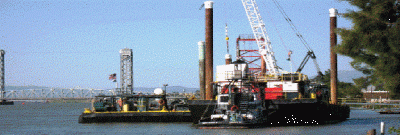The Delta
Sacramento and the Deep Water Ship Channel
Completed by the United States Army Corps of Engineers in 1963, cargo ships access the Port of Sacramento through San Francisco Bay and passage up the Sacramento River using this Sacramento deep water channel which is 43 miles long with an approximate depth of 30 feet and areas up to 200 feet wide. The Port of Sacramento is used for the export of bagged and bulk rice. Construction materials such as cement, lumber, and fertilizer make up a great deal of the Port’s cargo volume. The Port is also used for the importation of large project cargo such as wind power generation equipment.
Northern Delta
Joining the Sacramento River just above Old Sacramento is the American River. Together they wind through the Delta and pass lovely little river towns such as Freeport, Clarksburg, and Courtland. These burgs and their quiet streets offer leisurely strolls to visitors.
There is also historically rich Old Sacramento, where Sutter established his Embarcadero and where Pony Express riders made their last westward stop; from there, the mail went by steamer to San Francisco.
Little changed from the days of the Gold Rush, Old Sacramento offers modern delights also: several dozen fine restaurants, gift shops, apparel, and out on the wharf, a memorable marketplace that sells fresh vegetables and fruits.
Over Memorial Day Weekend Old Sac’ is alive with the Dixieland beat during the four-day Sacramento Jazz Jubilee. A historical experience itself, driving down Hwy.160, visitors can refresh themselves with views of stately old homes surrounded by grand pear-tree orchards.
Central Delta
There is a country flavor to the Sacramento River towns of Locke, Walnut Grove, Isleton, and Rio Vista. Agriculture is important here. And in areas behind Locke and Walnut Grove, there are great anchorage and wildlife areas. Hwy. 12 goes through here and assures access to the resorts near islands such as Andrus and Brannan. On east over Little Potato Slough drawbridge at the ghost town Terminous, the highway takes visitors to the historic communities of Lodi and Woodbridge, also noted for fine wines and vineyards.
Many resorts beckon from Andrus Island’s Delta Loop, and at Terminous, Tower Park has approximately 400 RV sites and facilities. Perhaps the prettiest of the many pretty Delta towns may be Rio Vista; its backdrop is the Montezuma Hills, and nearby waters find anglers hoping for catches of striped bass.
“Crawdad Town U.S.A.” is Isleton. But it was also once called “Little Paris of the Delta.”
There is truly something for everyone – from Disappointment Slough to Georgiana Slough – in the 1,000-mile Delta.
Western Delta
Waterfront living is a way of life in the western part of the Delta – in Brentwood, Oakley, and Discovery Bay. It is an easy, cultivated pace of living.
Bethel Island, the largest, depends on tourists, boaters, RVers as its “cash crop.” Recreational facilities abound here.
Western Delta
Waterfront living is a way of life in the western part of the Delta – in Brentwood, Oakley, and Discovery Bay. It is an easy, cultivated pace of living.
Bethel Island, the largest, depends on tourists, boaters, RVers as its “cash crop.” Recreational facilities abound here.
Both black and striped bass are popular catches in the Western Delta, and if waterskiing is your preference over angling, some of the finest waters for the sport are here.
Gateway to the Delta is the huge Antioch Bridge. Beyond, windsurfers delight in Sherman Island waters.
The annual Seafood Festival in Pittsburg is a reminder that it was once home to commercial fishermen and canneries. The festival includes significant offshore boat races.
Orchards where visitors can pick the fruit themselves and acres of nut trees are reminders of the Western Delta heritage.
See the links below for a few Delta websites.

